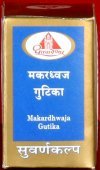Nagavalli, Nāgavallī, Naga-valli: 15 definitions
Introduction:
Nagavalli means something in Hinduism, Sanskrit, the history of ancient India, Marathi, biology. If you want to know the exact meaning, history, etymology or English translation of this term then check out the descriptions on this page. Add your comment or reference to a book if you want to contribute to this summary article.
In Hinduism
Ayurveda (science of life)
Dietetics and Culinary Art (such as household cooking)
Source: Shodhganga: Dietetics and culinary art in ancient and medieval IndiaNāgavallī (नागवल्ली) refers to “betel leaf” and is mentioned in a list of potential causes for indigestion in the 17th century Bhojanakutūhala (dravyaguṇāguṇa-kathana), and is commonly found in literature dealing with the topics of dietetics and culinary art, also known as Pākaśāstra or Pākakalā.—A complete section in Bhojanakutūhala is devoted for the description of agents that cause indigestion [viz., nāgavallī (betel leaf)]. These agents consumed on a large scale can cause indigestion for certain people. The remedies [viz., kāñjika gruel)] for these types of indigestions are also explained therewith.
Kalpa (Formulas, Drug prescriptions and other Medicinal preparations)
Source: Shodhganga: Edition translation and critical study of yogasarasamgrahaNāgavallī (नागवल्ली) is another name for “Tāmbūla” and is dealt with in the 15th-century Yogasārasaṅgraha (Yogasara-saṅgraha) by Vāsudeva: an unpublished Keralite work representing an Ayurvedic compendium of medicinal recipes. The Yogasārasaṃgraha [mentioning nāgavallī] deals with entire recipes in the route of administration, and thus deals with the knowledge of pharmacy (bhaiṣajya-kalpanā) which is a branch of pharmacology (dravyaguṇa).

Āyurveda (आयुर्वेद, ayurveda) is a branch of Indian science dealing with medicine, herbalism, taxology, anatomy, surgery, alchemy and related topics. Traditional practice of Āyurveda in ancient India dates back to at least the first millenium BC. Literature is commonly written in Sanskrit using various poetic metres.
India history and geography
Source: Singhi Jain Series: Ratnaprabha-suri’s Kuvalayamala-katha (history)Nāgavallī refers to a particular type of leaf used to beautify the Sleeping chamber (of young ladies) in Ancient India, as depicted in the Kathās (narrative poems) such as Uddyotanasūri in his 8th-century Kuvalayamālā (a Prakrit Campū, similar to Kāvya poetry).—The Kuvalayamala (779 A.D.) is full of cultural material which gains in value because of the firm date of its composition. [...] Page 83.3-9: Here is the description of the house or the sleeping chambers of young ladies which were beautified for the reception of their husbands. The select items in this list are as follows: [e.g., prepare clusters of nāgavallī leaves in their cases;] [...]

The history of India traces the identification of countries, villages, towns and other regions of India, as well as mythology, zoology, royal dynasties, rulers, tribes, local festivities and traditions and regional languages. Ancient India enjoyed religious freedom and encourages the path of Dharma, a concept common to Buddhism, Hinduism, and Jainism.
Biology (plants and animals)
Source: Wisdom Library: Local Names of Plants and DrugsNagavalli [नागवल्ली] in the Sanskrit language is the name of a plant identified with Piper betle L. from the Piperaceae (Pepper) family having the following synonyms: Piper chawya, Piper malamiris, Piper densum. For the possible medicinal usage of nagavalli, you can check this page for potential sources and references, although be aware that any some or none of the side-effects may not be mentioned here, wether they be harmful or beneficial to health.
Naga-valli [നാഗ വല്ലീ] in the Malayalam language is the name of a plant identified with Phanera scandens (L.) Lour. ex Raf. from the Caesalpiniaceae (Gulmohar) family having the following synonyms: Bauhinia scandens, Bauhinia debilis, Bauhinia anguina.
Source: Google Books: CRC World Dictionary (Regional names)Nagavalli in India is the name of a plant defined with Bauhinia scandens in various botanical sources. This page contains potential references in Ayurveda, modern medicine, and other folk traditions or local practices It has the synonym Phanera debilis (Hassk.) Miq. (among others).
Example references for further research on medicinal uses or toxicity (see latin names for full list):
· Flora Mexicana (1894)
· J. Natal. Bot. See. (2000)
· Flora van Nederlandsch Indië (1855)
· Reinwardtia (1956)
· Species Plantarum (1753)
· Enum. Flow. Pl. Nep. (1979)
If you are looking for specific details regarding Nagavalli, for example diet and recipes, side effects, health benefits, extract dosage, pregnancy safety, chemical composition, have a look at these references.

This sections includes definitions from the five kingdoms of living things: Animals, Plants, Fungi, Protists and Monera. It will include both the official binomial nomenclature (scientific names usually in Latin) as well as regional spellings and variants.
Languages of India and abroad
Marathi-English dictionary
Source: DDSA: The Molesworth Marathi and English Dictionarynāgavallī (नागवल्ली).—f (S) The betel-plant, Piper betel.
Source: DDSA: The Aryabhusan school dictionary, Marathi-Englishnāgavallī (नागवल्ली).—f The betel-plant.
Marathi is an Indo-European language having over 70 million native speakers people in (predominantly) Maharashtra India. Marathi, like many other Indo-Aryan languages, evolved from early forms of Prakrit, which itself is a subset of Sanskrit, one of the most ancient languages of the world.
Sanskrit dictionary
Source: DDSA: The practical Sanskrit-English dictionaryNāgavallī (नागवल्ली).—piper betel.
Nāgavallī is a Sanskrit compound consisting of the terms nāga and vallī (वल्ली). See also (synonyms): nāgavallarī.
Source: Cologne Digital Sanskrit Dictionaries: Shabda-Sagara Sanskrit-English DictionaryNāgavallī (नागवल्ली).—f. (-llī) The betel plant, (Peper betel.) E. nāga the infernal Naga, and vallī a creeper; the creeper of the lower regions; also with kan added nāgavallikā .
Source: Cologne Digital Sanskrit Dictionaries: Aufrecht Catalogus CatalogorumNāgavallī (नागवल्ली) as mentioned in Aufrecht’s Catalogus Catalogorum:—[dharma] Oppert. 2183.
Source: Cologne Digital Sanskrit Dictionaries: Monier-Williams Sanskrit-English Dictionary1) Nāgavallī (नागवल्ली):—[=nāga-vallī] [from nāga] f. idem, [Rāmāyaṇa] (also li, [Śiśupāla-vadha ix, 35], likā, [cf. Lexicographers, esp. such as amarasiṃha, halāyudha, hemacandra, etc.])
2) [v.s. ...] Name of [work] (also -kalpa, m.)
Source: Cologne Digital Sanskrit Dictionaries: Yates Sanskrit-English DictionaryNāgavallī (नागवल्ली):—[nāga-vallī] (llī) 3. f. Idem.
[Sanskrit to German]
Sanskrit, also spelled संस्कृतम् (saṃskṛtam), is an ancient language of India commonly seen as the grandmother of the Indo-European language family (even English!). Closely allied with Prakrit and Pali, Sanskrit is more exhaustive in both grammar and terms and has the most extensive collection of literature in the world, greatly surpassing its sister-languages Greek and Latin.
Kannada-English dictionary
Source: Alar: Kannada-English corpusNāgavalli (ನಾಗವಲ್ಲಿ):—
1) [noun] the climbing plant Piper betle of the Piperaceae family.
2) [noun] its leaf.
--- OR ---
Nāgavaḷḷi (ನಾಗವಳ್ಳಿ):—[noun] = ನಾಗವಲ್ಲಿ [nagavalli].
Kannada is a Dravidian language (as opposed to the Indo-European language family) mainly spoken in the southwestern region of India.
See also (Relevant definitions)
Starts with: Nagavallika, Nagavallikalpa, Nakavalli.
Ends with: Mamdaranagavalli, Nakavalli.
Full-text: Sarpalata, Nagavallikalpa, Nakavalli, Nagalate, Shrivati, Nagavela, Bhujamgalata, Adhripushkalika, Phanilata, Saptashiva, Nagavallari, Junavata, Niyamana, Kanjika, Sleeping chamber, Ara, Valli, Abhishta.
Relevant text
Search found 7 books and stories containing Nagavalli, Nāgavallī, Naga-valli, Nāga-vallī, Nāgavalli, Nāgavaḷḷi; (plurals include: Nagavallis, Nāgavallīs, vallis, vallīs, Nāgavallis, Nāgavaḷḷis). You can also click to the full overview containing English textual excerpts. Below are direct links for the most relevant articles:
Garga Samhita (English) (by Danavir Goswami)
Verse 1.9.8 < [Chapter 9 - Description of Vasudeva’s Wedding]
Verse 4.19.53 < [Chapter 19 - A Thousand Names of Srī Yamunā]
Amarakoshodghatana of Kshirasvamin (study) (by A. Yamuna Devi)
Flora (6): Creepers < [Chapter 5 - Aspects of Nature]
The Skanda Purana (by G. V. Tagare)
Chapter 210 - Importance of Tāmbūla < [Section 1 - Tīrtha-māhātmya]
Chapter 22 - Soma Gets a Boon < [Section 1 - Prabhāsa-kṣetra-māhātmya]
The Padma Purana (by N.A. Deshpande)
Chapter 65 - Cāturmāsya Vow to be Concluded Properly < [Section 6 - Uttara-Khaṇḍa (Concluding Section)]
The Agni Purana (by N. Gangadharan)
Chapter 224 - Duties of a King in the Harem (antaḥpura)
Chapter 285 - The accomplished recipes that would revive the dead (mṛtasañjīvanī)
Chapter 363 - The words denoting earth, city, forest and herbs
The Girl I Murdered < [April 1968]
Related products


